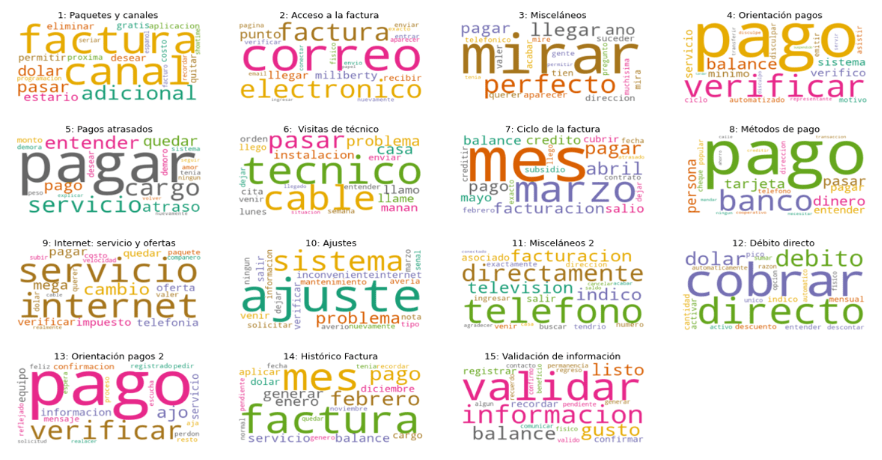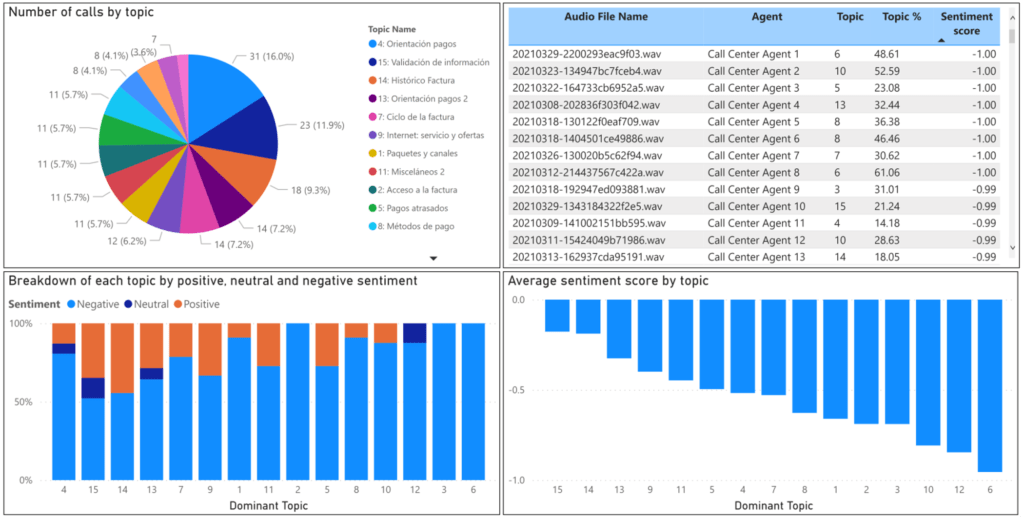- Natural Language Processing (NLP), a subfield of linguistics, computer science, and artificial intelligence, is used to extract insights from thousands of hours of recorded audio or millions of written pages without needing to hear or read what they say.
- Some of the most popular applications of NLP are “Speech to Text Transcription”, “Sentiment Analysis”, “Topic Modeling”, “Named-Entity Recognition”, and “Intent Recognition”.
- These applications are used, among other things, to understand how satisfied or discontent are customers when contacting customer service by text or phone, to identify the main topics from vast amounts of text, to understand what clients and potential clients think about the competition or about a new product recently launched, and to identify the intent of customers expressed in calls or through text.
- At V2A, we have recently applied NLP for a Telecom Company to understand why clients call customer service and what topics generate more discontent among customers.
OVERVIEW
It is well known that you can extract valuable insights from a structured data set, namely a set of columns and rows of labeled information. But what if you could extract the same kind of insights from thousands of hours of recorded audio or millions of written pages without even needing to hear or read what they say? That is what Natural Language Processing (NLP) is for.
Elizabeth D. Liddy (2011), Dean of the Syracuse University School of Information Studies and a pioneer in the field of natural language processing, offers us the following definition:
“Natural Language Processing is a theoretically motivated range of computational techniques for analyzing and representing naturally occurring texts at one or more levels of linguistic analysis for the purpose of achieving human-like language processing for a range of tasks or applications.”
Simply put, all images, documents, audio, and video files are stored as bits (0 or 1s) in our computers, and from those very bits, and using machine learning algorithms, computers can learn to identify words, phrases, sentences, and their lexical and semantic relations.
APPLICATIONS
To better put all of this in context, let’s explore some of the most useful NLP techniques and their applications:
Speech to Text Transcription
Using algorithms, you can transform spoken language into strings of text. The most widely known implementations of this technology are virtual assistants such as Siri, Google, or Alexa.
Using this technology, you can also set up a virtual scribe for meetings or even a live translator.
Sentiment Analysis
Sentiment analysis refers to extracting subjective information (mainly emotions or opinions) from text or previously transcribed audio (Medhat & others, 2014).
This group of algorithms is useful when monitoring social media and the interaction with customers. For example, a company could use sentiment analysis to assess the impact of a marketing campaign, to learn the level of satisfaction of a product among its users, to capture how irritated a customer is when calling customer service, or to monitor how effective an agent can be in turning the customer’s mood from negative to positive.
Want to see live NLP? Write a comment about what you have read so far and let us find out its sentiment:
V2A Podcast
Natural Language Processing
Topic Modeling
Topic Modeling algorithms can iterate over entire papers or books to identify the main topics in them in the form of related keywords with correlated appearances.
A good application for this technology could be for a law firm to classify documents, extracts, and scanned pages into relevant categories to facilitate the storing and search processes.
Named-Entity Recognition (NER)
NER is a subtask of information extraction that locates and classifies specific entities (e.g., companies, products, cities, countries, famous artists, …) in unstructured text, and analyses what is being said about them in that text. There are many questions that can be answered using NER. For example:
- What do my customers think of my new product or service? Is it working properly?
- Is my product too expensive or too cheap?
- Are there any delivery or installation problems?
- What do my customers say about my competitors? What are their strengths and weaknesses?
- Why do clients purchase my competitors’ goods/services?
- How did my customers react to my latest telemarketing campaign? And what offers/features did they like?
Intent Recognition
Intent recognition is the task of taking a written or spoken input and classifying it based on what the user wants to achieve. Intent recognition forms an essential component of chatbots and is widely used in sales conversations, customer support, and many other areas.
V2A CONSULTING IMPLEMENTATIONS
On most occasions, organizations require the deployment of several of these solutions to tackle multiple problems. At V2A Consulting we have recently applied three of these algorithms together in the call centers of a Telecom company. The sequence of that deployment went as follows:
- Speech to text transcription of the customer service calls to enable analyses of the customer-agent conversations in text format
- Topic modeling analysis to find out the main reasons driving clients to call customer service. The topics identified by the LDA1 algorithm used were actionable. For example, the billing-related calls (based on the call center categorizations) were further segmented into 15 topics (see Figure 1). One of these topics was “Plans and Channels” and it identified a specific channel that came free by default for 1 month with an automatic enrollment after the free period. This offer generated multiple calls from customers being charged unexpectedly after the free month period. The topic analysis allowed the organization to take action by ensuring new customers were always oriented about the offer and automatic enrollment.
Figure 1: Example of topic modeling example in Telecom company

- Sentiment analysis to understand which topics cause greater dissatisfaction among customers (see Figure 2) and to monitor the ability of call center agents to take care of the customers’ claims and concerns based on the level of customer satisfaction/dissatisfaction
Figure 2: Example of sentiment analysis by topic in Telecom company

Another recent application of NLP in a customer service call center by V2A Consulting was related to intent recognition. Specifically, one of our Data Scientists built an algorithm to capture in real-time the need or question being expressed by the customer as he interacted with the agent. This “intent” was cross-referenced against a repository of Q&A documents and a suited course of action was selected and presented to the call center agent to better serve the customer.
So, are you not taking advantage of your audio and text data? Let us implement an NLP solution for you and take your organization to the next level.
1 Latent Dirichlet Allocation (LDA) is an unsupervised graphical model which can discover latent topics in unlabeled data (Andrzejewski & Zhu, 2009).
References
Liddy, E. Natural Language Processing (2011). https://surface.syr.edu/cgi/viewcontent.cgi?article=1043&context=istpub#:~:text=Definition%3A%20Natural%20Language%20Processing%20is,range%20of%20tasks%20or%20applications.
Medhat, W., Hassan, A. & Korashy, H. (2014). Sentiment analysis algorithms and applications: A survey. https://www.sciencedirect.com/science/article/pii/S2090447914000550
Andrzejewski, D. & Zhu, X. (2009). Latent Dirichlet Allocation with Topic-in-Set Knowledge.
Disclaimer
Accuracy and Currency of Information: Information throughout this “Insight” is obtained from sources which we believe are reliable, but we do not warrant or guarantee the timeliness or accuracy of this information. While the information is considered to be true and correct at the date of publication, changes in circumstances after the time of publication may impact the accuracy of the information. The information may change without notice and V2A is not in any way liable for the accuracy of any information printed and stored, or in any way interpreted and used by a user.
ONLY ENGLISH VERSION
